This is a fortnightly newsletter about the New Zealand Net. If you would like to be notified by email when a new edition is published, please contact ZL1NZ.
Browse our newsletter Archive and List of Net Tips.
Featured key

This interesting key sold on Trade Me a few weeks ago.
Maybe you noticed this key for sale recently. I was interested in knowing more about it, and learned that it is most likely a Hayakawa 1100 Radio Key, made in Japan.
There are some interesting photos and information on Hayakawa keys at brundrit.co.uk and telegraphkeys.com.
Tokuji Hayakawa founded a metal workshop in Tokyo in 1912. Among his successful products were an innovative buckle and an automatic pencil. He later moved into radio products, and renamed his company Sharp (a reference to the pencil). This is the same company we know for its consumer electronics, including calculators, tape recorders, televisions and radios.
* If you have an interesting key for this feature, please send me a nice clear photo and a few words describing it.
Quick notes
The link to our online audio archive from the NZ Net homepage has been fixed. Thanks Gerard ZL2GVA for letting me know the old link was wrong. The archive includes all of our weekly trivia questions, monthly net reports and examples of QTC and net procedure.
 A good friend spent last weekend in my shack doing the CQ WPX Contest (SSB). He was in the single op, 100W category. Every few hours I dropped into the shack to see how he was getting on, and it seemed that 15m was the busiest band. It got me thinking maybe I should give the CW version of this contest a try. It’s the last weekend of May. Anybody else thinking of joining the fun? [Contest info]
A good friend spent last weekend in my shack doing the CQ WPX Contest (SSB). He was in the single op, 100W category. Every few hours I dropped into the shack to see how he was getting on, and it seemed that 15m was the busiest band. It got me thinking maybe I should give the CW version of this contest a try. It’s the last weekend of May. Anybody else thinking of joining the fun? [Contest info]
Paul ZL1AJY reminds me that another CW contest, the Sangster Shield, is coming up on 15/16 May. Power limit is 5W, and you must be an NZART member to compete.
Maritime Radio Day is also fast approaching. MRD is held annually on the anniversary of the loss of RMS Titanic in 1912. This CW-only event – a great opportunity to practise your QRKs and QSAs – runs from 14 April 1200 UTC to 15 April 2200 UTC.
Email issues? If you have asked to be on the email notification list for NZ Net News, but you are not receiving the emails (sent every second Friday evening around 2200 hours NZT) or you are receiving them sporadically, please contact me to help me troubleshoot the issue. The most recent notification was sent via Mailchimp which may have improved deliverability to some addresses, but may also still need some refinement. (If you are a Gmail user, the notification may have landed in your Promotions tab. If you drag the email to your Primary tab, Gmail should treat it properly next time.) Thanks.
Cartoon: Gildersleeve
Time change: Overseas ops please note
 This weekend clocks in New Zealand go back one hour.
This weekend clocks in New Zealand go back one hour.
Although the NZ Net is always at 2100 hours NZ time, that time will now be 0900Z instead of 0800Z.
Losing an hour of daylight may not seem like anything to celebrate, but we can look forward to even better propagation around NZ during the evening on 80m, and gradually improving signals from our mates in Australia as we head into winter. 🙂
Net numbers
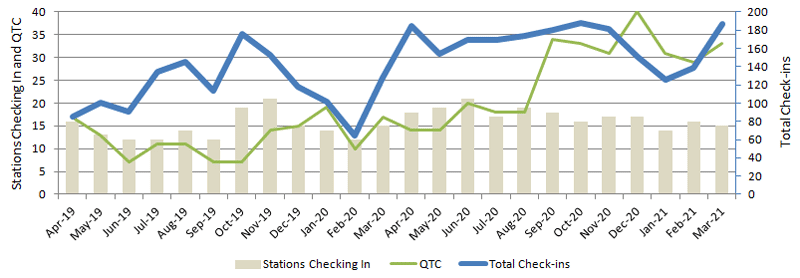
March saw 187 check-ins to NZ Net, just one short of our record set in October last year. There were 15 stations checking in, and 33 pieces of formal traffic were passed.
NR32 R ZL1NZ 39/36 AUCKLAND 0800Z 1APR21 = NZ NET = MARCH QNI ZL1AJY 7 ZL1ANY 19 ZL1BWG 19 ZL1NZ 22 ZL1PC 3 ZL1RD 1 ZL2GD 17 ZL2GVA 21 ZL2KE 17 ZL2LN 5 ZL2WT 9 ZL4CU 4 ZL4KX 12 VK3DRQ 19 VK4PN 12 TOTAL 187 QTC 33 = ZL1NZ
Photo flashback
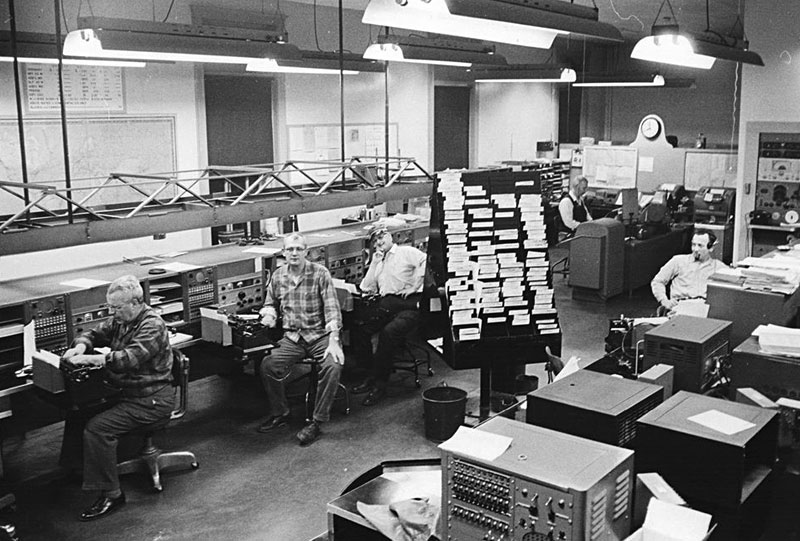
WCC Radio, North Chatham, Massachusetts, 1967
What a great photo of a great radio station! Chatham Radio WCC was a large and famous RCA coast station in the northeastern USA that began operation 100 years ago, in 1921. The receiving site is now home to the Chatham Marconi Maritime Center.
 I find it interesting that the operating positions in the 1967 photo show AR-88 receivers that date from World War Two. They were made by RCA, owners of WCC, so I guess they were loathe to retire them!
I find it interesting that the operating positions in the 1967 photo show AR-88 receivers that date from World War Two. They were made by RCA, owners of WCC, so I guess they were loathe to retire them!
These guys must also have had very steady hands. The marks on the AR-88 tuning dial are at every TEN kHz on MF, but every ONE HUNDRED kHz on most of the HF bands.
The carousel rack in the centre of the photo would have held traffic waiting to be sent to ships.
Small photo: An AR-88D receiver at ZL1NZ
Morse musing: learning the code
Our series continues, this time with Thomas VA3HN recalling how he learned the Code. If you haven’t sent me your story yet, please do!
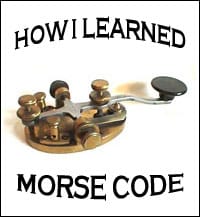 It was the fall of 1959 and I had been burning a hole in 3509 kHz as VE6TM for close to a year. After giving a few hints of what was to come, my dad sat me down at the kitchen table. He said that if I learned the family trade, I could have a good summer job to help pay for my university expenses.
It was the fall of 1959 and I had been burning a hole in 3509 kHz as VE6TM for close to a year. After giving a few hints of what was to come, my dad sat me down at the kitchen table. He said that if I learned the family trade, I could have a good summer job to help pay for my university expenses.
I agreed and my dad started to teach me American Morse telegraphy (AMT). Dad, sine Q, was then 69 years old and had held his first AMT job on the Chicago Terminal railroad (RR) in the summer of 1905 as a 15-year-old kid. He had learned the family trade from his brother Bill who was 10 years older and a Western Union operator.
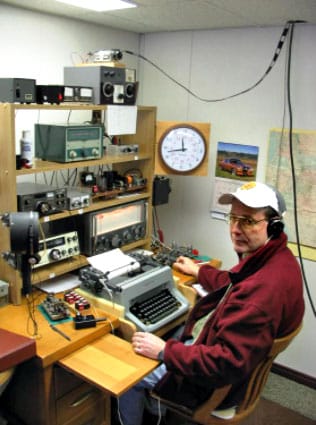 It took a while to catch on to the letter sounds made by the clacks and clicks of the sounder. The sound certainly was different from International Morse code (CW) and the fact that the two codes (AMT and CW) differed by 11 letters, nine numbers and all of the punctuation presented a challenge. Nevertheless, already knowing CW gave me a leg up.
It took a while to catch on to the letter sounds made by the clacks and clicks of the sounder. The sound certainly was different from International Morse code (CW) and the fact that the two codes (AMT and CW) differed by 11 letters, nine numbers and all of the punctuation presented a challenge. Nevertheless, already knowing CW gave me a leg up.
Dad said I picked up AMT quicker than anyone else that he had taught. At that time you had to be 18 to be a RR AMT operator in Canada, so dad found a summer job for me as an assistant agent on the Canadian National Railway for the summer of 1960. Then I worked the next two summers as an AMT Operator on the Canadian Pacific Railway in southern Alberta and British Columbia.
Continue reading (especially recommended for typewriter fans)
How did you learn CW? Drop me a line and I’ll post the replies in future newsletters.
Trivia answer
This week’s trivia question asked for the location of radio station H3RC. That’s a Panamanian callsign, but the answer is more complicated.
One correct reply would have been “in the Suez Canal” since H3RC is the callsign of the container ship Ever Given, which ran aground and blocked the canal for several days.
Gerard ZL2GVA was more precise, giving the location as “Great Bitter Lake Egypt” which is part of the Suez Canal and is where the ship was towed after being freed from the canal bank. (They probably have some paperwork to sort out.)

Unconfirmed reports suggest that Theodore Tugboat helped rescue Ever Given.
Audio challenge: HLG traffic list
How did you get on with copying the HLG traffic list in the previous newsletter?
A few people emailed me with their copy, which goes like this:
DTAE8 DTAL9 HLLG HLWJ 6LCU 6LHV 6MCI 6MIO 6MOX 6MSQ 6MWW 6MXF 6NFC 6NJU
Although this was just a random recording, it really does demonstrate the value of repetition. Several of the callsigns in the list were hard to copy due to QSB, but because they were each sent twice, it was easy to get them all.
Video: Upside down Morse
For NZ Net News readers in the Northern Hemisphere, yes, this is how we send Morse downunder. 😉
Net tip: NM
You may hear an operator send “NM” right after the end-of-message signal, like this:
... <AR> NM
NM means “no more” and indicates that the sending station has no further traffic to send to that particular station. It’s not always used, but can be helpful in avoiding confusion.
What if there IS more traffic to send?
Then, instead of “NM”, the sending operator will send the number of messages still to come, as in:
... <AR> 1
The receiving operator could respond with something like:
QSL NR# QRV
after which the sending op would begin sending the next message.
See the full List of NZ Net Tips.
Advertising archive
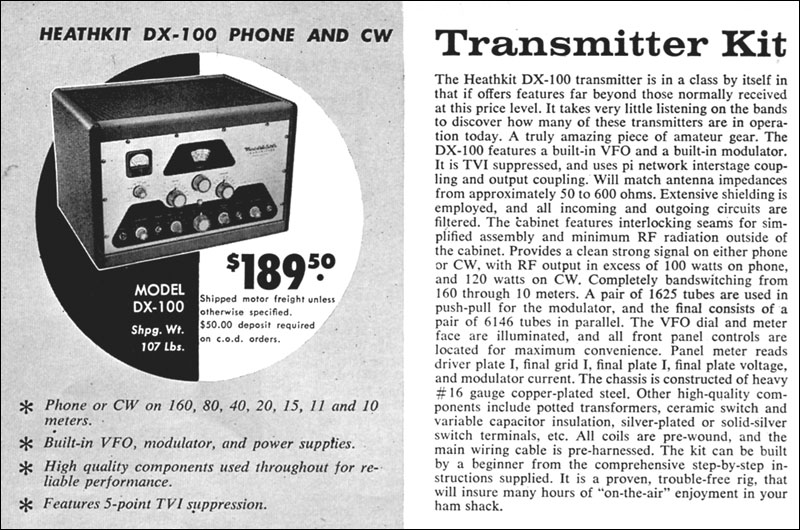
Heathkit DX-100 transmitter, QST magazine, November 1956
Suggestions?
If you have suggestions on how to make the NZ Net better, or things you’d like to see covered in these updates, please contact ZL1NZ. You might even like to write something for the newsletter.
Thanks for reading, and I hope to see you soon on the NZ Net!
—
Neil Sanderson ZL1NZ, Net Manager
New Zealand Net (NZ NET)
3535.0 kHz at 9pm NZT Mon-Fri



